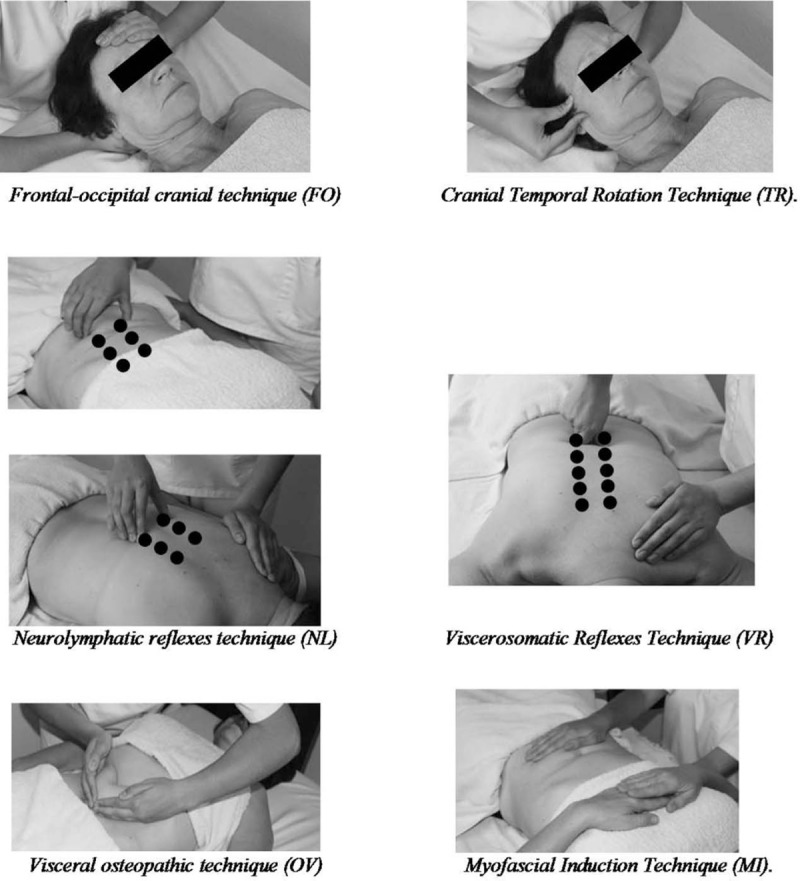Crohn’s disease (CD) is an inflammatory bowel disease characterized by recurring flares altered by periods of inactive disease and remission, affecting physical and psychological aspects and quality of life (QoL). The aim of this study was to determine the therapeutic benefits of soft non-manipulative osteopathic techniques in patients with CD.
A randomized controlled trial was performed. It included 30 individuals with CD who were divided into 2 groups: 16 in the experimental group (EG) and 14 in the control group (CG). The EG was treated with the 6 manual techniques depicted below. All patients were advised to continue their prescribed medications and diets. The intervention period lasted 30 days (1 session every 10 days). Pain, global quality of life (GQoL) and QoL specific for CD (QoLCD) were assessed before and after the intervention. Anxiety and depression levels were measured at the beginning of the study.
A significant effect was observed of the treatment in both the physical and task subscales of the GQoL and also in the QoLCD but not in pain score. When the intensity of pain was taken into consideration in the analysis of the EG, there was a significantly greater increment in the QoLCD after treatment in people without pain than in those with pain. The improvements in GQoL were independent from the disease status.
The authors concluded that soft, non-manipulative osteopathic treatment is effective in improving overall and physical-related QoL in CD patients, regardless of the phase of the disease. Pain is an important factor that inversely correlates with the improvements in QoL.
Where to begin?
Here are some of the most obvious flaws of this study:
- It was far too small for drawing any far-reaching conclusions.
- Because the sample size was so small, randomisation failed to create two comparable groups.
- Sub-group analyses are based on even smaller samples and thus even less meaningful.
- The authors call their trial a ‘single-blind’ study but, in fact, neither the patients nor the therapists (physiotherapists) were blind.
- The researchers were physiotherapists, their treatments were mostly physiotherapy. It is therefore puzzling why they repeatedly call them ‘osteopathic’.
- It also seems unclear why these and not some other soft tissue techniques were employed.
- The CG did not receive additional treatment at all; no attempt was thus made to control for placebo effects.
- The stated aim to determine the therapeutic benefits… seems to be a clue that this study was never aimed at rigorously testing the effectiveness of the treatments.
My conclusion therefore is (yet again) that poor science has the potential to mislead and thus harm us all.


The applied manual techniques shown here are a mishmash or patchwork of osteopathic soft touch or cranial techniques indeed. Such an applied soft touch carousal might have the same unspecific vague effect like autogenic training.
There are 2 systematic review about this approaches:
https://www.ncbi.nlm.nih.gov/m/pubmed/29452579/
https://www.ncbi.nlm.nih.gov/pmc/articles/PMC5147986/
Another study with 38 patients in 2014 in France about osteopathy and IBS following M. Crohn:
https://www.ncbi.nlm.nih.gov/m/pubmed/25357218/
https://insights.ovid.com/pubmed?pmid=25357218
On a separate topic, I thought you’d be interested in this: Cancer crowdfunding ‘couldn’t save my daughter’ http://www.bbc.co.uk/news/health-47442946
I read that this morning – I think it is worthy of a separate post.
It is shocking, and very sad when someone who is terminally ill, or their family, devotes all their time and resources in pursuit of a non-existant cure, instead of using their precious limited time to be together as a family and perhaps to address a bucket list.
Of course such clinics are always going to have some success stories. By definition, for any given condition or cancer stage half of all patients will live longer than the median survival, and since survival (like most things in biology) tends to follow a bell curve, a few will live substantially longer. Everyone who has treated cancer knows this, and to take credit for it is dishonest and misleading. Though I understand that this particular clinic uses testimonial videos of peope who have subsequently died of their disease, which strikes me as particularly cynical.
see also this:
https://edzardernst.com/2018/07/germany-the-promised-land-for-cancer-quacks/
If these people were selling fake monetary instruments, even involving lesser amounts, wouldn’t police be knocking down their doors? Selling fake medicine seems to be exempt from judicial liability. How can this be changed?